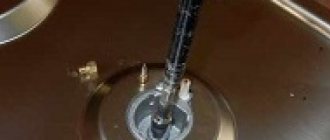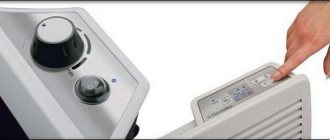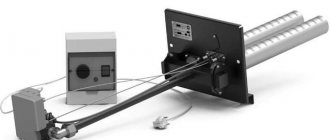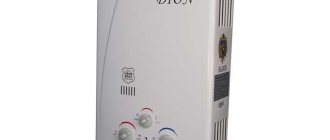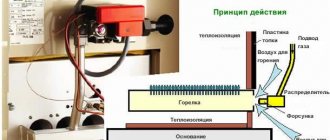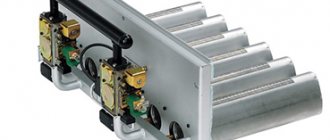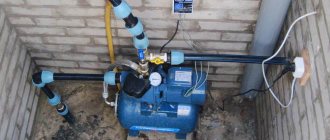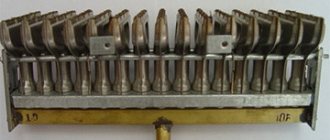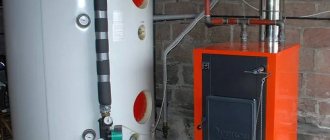Natural gas is one of the most common, accessible and inexpensive types of fuel. Therefore, it is often used both for heating private houses and for producing hot domestic water for a variety of purposes, including baths, swimming pools and saunas. Let's look at what a gas burner for a bathhouse is, as well as heating equipment, on what principle it operates, on what criteria it is classified and into what types it is divided, as well as how to correctly calculate its power for specific conditions of use.
Sauna stove based on a gas burner Source teplodar.ru
Main selection criteria
Experienced buyers advise when choosing a gas burner to consider the following parameters:
- – The main thing is to decide on the purpose of purchasing the burner. To perform construction work and simple household needs, different models are needed.
- – For construction work, it is best to choose a gun-shaped torch. It will be convenient to hold it in one hand, while the other can be used to support the material with which you are working.
- – Manufacturers offer compact models for hiking and trips to the country. They can easily fit in a backpack or car glove compartment.
- – Models with a low melting point are suitable for soldering pipes.
- – One of the main parameters is gas consumption. This will allow you to calculate how long one replacement cylinder will last.
Briefly about the main thing
A gas burner is a special device for burning natural gas to generate heat and use it to heat water or a room. It is used in house and sauna stoves and heating boilers. The design includes such basic elements as a nozzle, an ignition system, a flame control sensor and automation. The principle of operation is based on supplying gas to the nozzle and igniting it in response to a command from the control unit - depending on the temperature of the heated area.
The resulting flame heats the surface of the furnace body or the heat exchange circuit with the coolant. A modern gas burner must have high efficiency, noiselessness and durability. The main advantages of using it for a stove in a bathhouse are its smaller size, faster heating, efficiency and the ability to accurately control the temperature. Disadvantages manifest themselves in the need for strict compliance with special requirements and safety rules.
Existing types of gas burners installed in the stove of a bathhouse or at home, as well as in heating units, are classified according to the following parameters:
- Power settings options.
- Air supply mechanism.
- Type of ignition.
- Scope of application.
Each variety has its own number of advantages and disadvantages. When choosing equipment for specific application conditions, it is important to correctly calculate the power.
Types of portable burners
Gas burners are devices that differ in design and purpose, but they are united by a common feature - they operate using gas.
Portable devices designed to operate from a small tube filled with propane-butane or other gas should not be confused with ovens or powerful welding units that operate from natural gas or a large cylinder.
We offer a brief overview of the main design elements of an inexpensive gas cartridge burner, which serves as an excellent example of a home device. It may be useful for repairs in the country or for a barbecue.
Using a compact device, you can quickly light a barbecue, heat bolts or nuts in the cold, melt plastic parts, and process heat shrinks. The flame temperature (up to +1300°C) is enough for soldering metal pipes.
This is an example of a burner type that is popular among users, but the range of devices is much wider. Let's look at the most popular types.
Difference by area of use
An open flame may be required at home, on vacation, and during installation work. One of the areas of application is tourism. When camping, use a simple device to light a fire and heat up canned food.
Devices for heating food have a special design - instead of a muzzle-nozzle, there is a long thin gas supply hose to an external burner with a stand
Burners with a directional torch of a “pistol” type are often used in installation work when soldering copper pipes and for bending plastic elements.
The flame, heated to the required temperature, is directed to the mating area of the copper parts, resulting in a strong permanent connection between pipe and pipe or fitting.
High-temperature high-power lamps can also process steel parts, but this requires hard solder and a slightly modified soldering technique.
Gas portable burners are also used for the following work:
- processing of wooden parts;
- lighting a barbecue or a fire in the country without the use of chemicals;
- calcination and cutting of metal blanks;
- singeing animal carcasses during butchering;
- thawing frozen pipelines.
This useful device is always at hand for craftsmen who love to improve their homes and improve their garden plots on their own. The burner can be useful in a car repair shop, during the construction of a greenhouse or other structures.
Division according to the method of attaching the can
The fuel cartridge is a consumable item. As soon as the fuel runs out, it is disconnected from the burner, and a new cartridge is installed in its place.
There are several ways to attach a cartridge to a device:
- threaded - fixed with a thread, in other words - screwed on;
- collet - put on and slightly rotated to one side;
- valve - secured with a retainer;
- pierced - connected with light pressure.
Threaded models are more common than others. They form a strong connection between two elements that can be separated at any time. Punctureable ones, on the contrary, cannot be turned off until the gas in the can runs out.
Devices with collet fixation are quickly installed. To attach them to the cylinder, you just need to put them on and turn them 25-30 degrees to the side
The weakness of collet devices is the rapid loosening of the clamp, resulting in loss of gas.
Valve burners, which are usually designed for heating food, are considered more reliable.
Differences in gas burners by fuel type
Manufacturers use various fuels to fill consumable cartridges. The choice of liquefied gas is based on the purpose of the burners, the required flame temperature, and power. To improve the characteristics of the composition, several different types of fuel are sometimes mixed.
The following combinations of substances are used most often:
- a mixture of propane and butane (70:30) - mainly for summer use, but with a heating device it is also used in winter;
- a combination of propane, butane and isobutane in various proportions;
- a mixture of MAPP - methyl acetylene-propadiene-propane, most often used for welding at temperatures of 1600-2500 ° C.
But there are cans filled with one gas, for example, butane.
An example of inexpensive gas cartridges is “Pathfinder”. Price – 90 rubles. Filling – universal gas fuel, suitable for portable burners, cutters, stoves, heaters
The choice of fuel is important when work is to be done in harsh conditions - in the cold or at high altitudes. And in the summer, any universal gas is suitable for lighting a barbecue or fire.
How to choose a gas burner for a spray can
This type of equipment is highly autonomous, which expands its scope of application. The simple design reduces the price and reduces scheduled maintenance to a minimum. The use of tight push-in connections ensures safety. Manufacturers offer models with injectors and check valves, working in conjunction with various types of tanks. Which nozzle to choose? It is not difficult to understand this issue. The buyer needs to understand the main purpose, pay attention to the presence of a flame regulator, piezo ignition and evaluate gas consumption. This will help you buy a tool that will last for several years.
Purpose
To light a fire in the country or during a camping trip, you can use the simplest nozzle, which can easily cope with the task or replace the stove if necessary to boil water. Such models have a flame temperature of 500-700 degrees and have a low price. Losing equipment during your next trip to nature will not be a serious loss. Tourists are advised to evaluate the size of the attachments, which should not take up much space in a backpack or car trunk.
For soldering, heating plastic and glass, you can use models with a torch temperature of 1200-1300 degrees. These are the most universal attachments, actively used in construction and in the home workshop. To solve specialized problems, for example, bending reinforcement, you will need powerful models with a flame temperature of 2200-2300 degrees. When choosing a tool, the conditions in which the user uses the burner are also taken into account. When used in conditions of limited space, nozzles with small sizes have an advantage.
Flame regulator
When choosing a universal model that is designed to solve different problems, nozzles with a flame regulator have an advantage. This device allows you to regulate the gas pressure and measure the power of the fire flow and its temperature. Using the regulator, the optimal mode is selected for soldering with copper or tin, heating a rusty part or old paintwork. The wider the adjustment range, the better for universal equipment.
The regulator should have a convenient location and allow you to change the power of the nozzle while working with the tool. Manufacturers who care about their customers put a power scale and direction of adjustment on the valve. This simplifies setting up the burner when performing critical tasks.
Piezo ignition
The piezo ignition system allows you to do without the use of matches when igniting the flame. This increases the safety of use: when igniting, accidental burns can be avoided. Piezo ignition is triggered in the wind and during rain, ensuring the operation of the device in all weather conditions. The spark instantly ignites the fuel, saving the user’s personal time. Piezo ignition must have a reliable and durable switching system: if the button breaks or sticks, then it will not be possible to use the piezo element for ignition. The system does not greatly increase the price of the tool, so it is recommended to choose models with piezo ignition.
Gas consumption
The nozzles are used with cylinders that have a limited fuel supply. The main part of the burners works in tandem with tanks that hold 220 grams of butane-propane mixture. The lower the fuel consumption, the longer the operating time. Consumption depends on the design features of the equipment. The optimal gas consumption is 75-80 grams per hour. This allows you to work for 2-2.5 hours.
Injection type nozzles have a higher flame temperature and power. High-temperature burners consume up to 120-140 grams of fuel per hour. To increase operating time, it is recommended to use 600 ml cylinders with such nozzles, which can hold more than 300 grams of the gas mixture.
TOP 7 best modifications
Hot water burners operating on the principle of burning a mixture of air and propane-butane are called portable torches. They operate from a gas cylinder, are affordable, have a simple design, compact dimensions and light weight, and do not cause any difficulties in operation.
Due to their reliability, safety and fairly high efficiency, mobile burners are widely used not only in construction. They are used to solve all kinds of household, economic, and industrial problems.
The principle of operation of the equipment is simple: a flammable substance under pressure is supplied to the valve through a hose, enters the mixing zone with air, after which the nozzle releases a flame onto the surface to be treated through a glass (mouthpiece)
Despite the general similarity, burners differ in certain features, technical characteristics, can be equipped with additional functions, and have a narrower or broader purpose.
One of the compact types of equipment are gas burners on a can, which are attractive due to their small size and mobility. To solve one-time problems, manufacturers have offered a number of mini burners, which find a wide range of applications in everyday life.
Each model has its own advantages and disadvantages. The products are used in almost all types of work where there is a need to heat the material.
Based on reviews from real users and opinions of industry experts, we have selected the seven best modifications produced by various foreign and domestic manufacturers.
1st place - DONMET GV 231
One of the universal models of the autogenous equipment plant, intended for economic and domestic work. The cost of a product positioned as an economy class varies between 800-900 rubles.
The handle of the device is made of durable wood. It is convenient to work with it for a long time. An improved valve extends the service life of the device and ensures its maintainability
Performance characteristics:
- device weight – 0.3 kg;
- product length – 40 cm;
- flammable substance – methane/propane;
- gas consumption – 1-1.3 m³/h;
- working pressure – 0.07-0.2 MPa;
- input connection – 0.6 cm;
- glass diameter – 3.5 cm.
Thanks to the improved design of the mouthpiece, the burner has increased resistance to wind, is lightweight, and ensures complete combustion of fuel. The principle of its operation is no different from similar models. It is based on the suction of external air and forced gas supply.
Using the open flame generated by the burner, metal elements are heated, reinforced concrete panels and brickwork are dried, polymer pipes are bent, and bituminous materials are melted.
Maximum heating temperature – up to 700 °C. The heat flow power in the device is 9.6/23.2 kW, which depends on the type of gas used.
Among the disadvantages of the burner, a limited radius of work is noted due to the short length of the gas supply tube. However, it is worth considering that compact dimensions provide additional advantages when processing hard-to-reach areas.
2nd place - KRASS GV-100-R
The burner of the Russian brand is produced with a lever fuel supply system, thanks to which it is possible to operate in an economical “standby” mode. The average cost of a product on the market is about 700 rubles.
The gas supply lever is located in such a way that it can be easily adjusted with one hand. The handle is made of heat-resistant plastic. The convenient shape of the handle greatly facilitates the work process
Performance characteristics:
- device weight – 0.37 kg;
- product length – 51 cm;
- flammable substance – propane-butane mixture;
- gas consumption – 0.57 m³/h;
- working pressure – 0.15 MPa;
- input connection – 0.63-0.9 cm;
- glass diameter – 3.5 cm.
An injection-type burner is used for heating and soldering workpieces made of ferrous/non-ferrous metals, drying casting molds, and firing old paintwork at home or in production.
The device is often used for indirect purposes. For example, heating car engines at low external temperatures, singeing animal skins in agriculture.
In general, users characterize the burner as a durable, wear-resistant and easy-to-use device. It provides instant heating, has optimal weight and dimensions, and is made of high-quality steel and brass. No significant disadvantages were noticed in this model.
3rd place - Sievert Turboroofer 60
The SIEVERT turboroofer model is a professional hot water burner made in Estonia. Its price is much higher than other devices participating in the rating, and is about 4,000 rubles.
This amount is justified by the absolute safety, high power and reliability of the equipment, which can be used to ensure the uninterrupted operation of various processes in construction and industry.
The device has several combustion modes - pilot, working, pulsating, constant. The package includes a handle with a regulator, a curved tube, a nozzle and a stand.
Performance characteristics:
- device weight – 0.92 kg;
- product length – 80 cm;
- flammable substance - propane;
- gas consumption – 8.25 m³/h;
- working pressure – 0.4 MPa;
- input connection – 0.6-0.9 cm;
- glass diameter – 6 cm.
A special feature of the device is an improved wind protection system, which provides significant advantages when performing welding work in difficult weather conditions. The burner creates a powerful flame flow, which is controlled by two valves and a trigger that switches operating modes. The heat flow power in the equipment reaches 140 kW.
The body is made of stainless steel and special materials with zinc coating. The reduced weight of titanium tips helps reduce the load on the body during painstaking, lengthy work.
The SIEVERT torch is considered one of the most ergonomic tools in its category.
The model is designed for heating roofing materials before melting, drying surfaces, various road, waterproofing and other large-scale works that require a powerful flame. The only drawback is the high cost.
4th place - Svarog GV-111
A manual valve-type injection burner from Svarog helps to cope with almost all types of work that require gas-flame processing - heating and soldering surfaces, drying roofs, fusing materials, repairing joints and abutment points of the roof, stripping off old paint.
The approximate price of the product is 500-600 rubles.
The convenient location of the valve makes it easy to regulate the gas supply. The plastic handwheel has arrows indicating the direction of rotation when opening/closing the valve block. This eliminates the possibility of making mistakes during adjustment
Performance characteristics:
- device weight – 0.42 kg;
- product length – 93 cm;
- flammable substance - propane;
- gas consumption – 2.2 m³/h;
- working pressure – 0.25 MPa;
- input connection – 0.6-0.9 cm;
- glass diameter – 5 cm.
The burner is equipped with a practical handle made of composite polymer materials, which are characterized by high fire resistance and strength. Good combustion power is achieved due to the well-thought-out design of the device.
The disadvantages of the product include a fairly high gas consumption and the lack of piezo ignition.
5th place - Foxweld Corundum GVP-1000R
The hot water burner model of the Italian brand is an example of excellent quality and good functionality. It costs about 800-1000 rubles.
The burner produces a stable flame with a temperature of 1100 to 1900 °C, which is controlled using a lever. Such a mechanism allows you to accurately control the amount of gas, the length of the flame, switch the device from operating to standby mode, adjusting the strength required at the current moment. Maximum heat flow power – 80 kW
Performance characteristics:
- device weight – 0.66 kg;
- product length – 100 cm;
- flammable substance – propane-butane;
- gas consumption – 4.5 kg/h;
- working pressure – 0.1-0.2 MPa;
- input connection – 0.6-0.9 cm;
- glass diameter – 6 cm.
The device is equipped with a large nozzle, which allows for large-scale roofing work. The tool is indispensable in the repair and construction of roofs and suspended structures; it is used for soldering, heating, drying and melting materials.
It is also used for road work and grass burning. Due to the sufficient length of the hose, it covers a fairly wide radius. The main structural parts of the device are made of metal and stainless steel. It is convenient to work with this burner while standing at full height.
Subject to all operating conditions regulated by the manufacturer, the equipment will last a long time even with regular use. It comes with a 12 month warranty. No significant disadvantages have been identified with the Foxweld hot water burner.
6th place - REDIUS GV-211-R
The burner of the Russian brand Redius is characterized by users as an effective, reliable and safe device for fire processing of various materials. The product costs about 800 rubles.
The torch is most suitable for soldering and heating metal products, stripping work, and fusing rolled bitumen materials. The increased length of the hose makes it easier to perform various types of work in hard-to-reach areas and at heights
Performance characteristics:
- device weight – 0.59 kg;
- product length – 90 cm;
- flammable substance - propane;
- gas consumption – 5 m³/h;
- working pressure – 0.02 MPa;
- input connection – 0.6-0.9 cm;
- glass diameter – 5 cm.
The model belongs to the line of high-power roofing burners, presented in a lever version. It is equipped with a durable design, adapted to use in harsh conditions, a practical curved shape, and an easy-to-maintain removable cup.
In addition to the equipment, you can purchase components for more comfortable and safe operation. For example, the manufacturer Redius produces special stands for hot water burners. Among the disadvantages of the GV-211-R burner is the significant consumption of combustible materials.
7th place - BAMZ GVM-1
The injection hot water burner of the Russian brand is easy to maintain and operate. The universal device is used in road and roofing work, for melting ice and removing weeds, repairing cable lines, and heating seams before welding. The average price of a product on the market is about 1200 rubles.
The recommended external temperature range during burner operation is from -15 to +45 °C. The safety of the equipment is confirmed by declarations of conformity. The model is equipped with an additional stand, which is attached to the tip with screws at a certain distance from the glass
Performance characteristics:
- device weight – 0.8 kg;
- product length – 90 cm;
- flammable substance – propane/methane;
- gas consumption – 0.7-1.5 m³/h;
- working pressure – 0.1-0.3 MPa;
- input connection – 0.6-0.9 cm;
- glass diameter – 5 cm.
The burner ensures complete combustion of gas and provides the ability to operate on methane. The elongated design allows you to work comfortably at full height without unnecessary movements. The intensity of the flame is regulated by a convenient lever adjacent to the handle of the device. Heating temperature – up to 500 °C.
The list of disadvantages of the burner includes difficulties with igniting and adjusting the flame, thickening of the fuel mixture in very frosty weather. However, this drawback is inherent in almost all devices in this category.
Tips for choosing the best burner
People buy compact hand burners with pleasure, as they have many advantages over liquid fuel, more “serious” devices. They light quickly, hardly get dirty, and require a minimum of care.
Using a manual model is easy: the flame power can be adjusted and the torch can be directed at any angle, which is important when working in cramped conditions
Criterion #1 – scope of use of the device
First of all, you should determine exactly what the gas appliance will be used for, since burners for soldering and for heating food are radically different in both design and parameters.
Tourist devices have the shape of a stand and resemble a household gas stove, on which it is convenient to place dishes with heated food
Construction tools often resemble a gun in shape. When working, it is convenient to hold them with one hand, and with the other at this time you can support the part or bring solder.
Criterion #2 – technical characteristics of the model
Characteristics such as weight and size are important if the burner has to be taken on hikes or often used at home. A heavy tool causes rapid fatigue, while a light one is much more comfortable to work with.
We pay attention to such characteristics as:
- flame temperature – from 480 to 2500°C;
- heating temperature – from 550 to 2500°C;
- power – 0.5-3 kW;
- the ability to connect cans with different fuels;
- method of connecting the cartridge to the burner;
- flame type, torch shape;
- fuel consumption – from 60 to 1000 g/h;
- weight – from 50 grams to 1.7 kg.
If you are purchasing a torch specifically for soldering copper pipes, then a low-temperature model will do.
To cut or weld steel parts, you will need a more powerful machine, usually called a torch or welding torch.
Overview of additional useful options:
It is not surprising that portable devices are popular, but when purchasing, you need to take into account all the nuances, including technical characteristics, design features, efficiency, and ease of use.
Rating of the best gas burners for a can
From all the variety, we can highlight the following models, which are most popular among buyers:
Rexant GT-19
Compact gas burner with adjustable flame level. Butane, propane and isobutane can be used as fuel. Fuel consumption – 80 g/h. Suitable for quickly heating surfaces. The maximum flame temperature is 1400 degrees Celsius. Price in stores – from 500 rubles.
ADVANTAGES:
- conveniently attaches to the cylinder with a click
- lights up the first time
- burns steadily
- There is a ignition button, the piece works properly
- sits tightly on the cylinder
FLAWS
- the gas is regulated very sharply, you need to turn the flame adjustment knob very smoothly
Rexant GT-19
Energy GTI-100
A high-power gas burner that can be used as a blowtorch. The main advantages are ease of use and compact size. Flame temperature – 1300 degrees Celsius. Another advantage is efficiency. Fuel consumption is only 80 g/h. Price – from 600 rubles.
ADVANTAGES:
- steady flame
- economical gas consumption
- presence of piezo ignition
- securely connects to the cylinder
- all plastic parts are located far from the heating point (they will not melt)
FLAWS
- when working with an inclination, preheating of the burner is necessary, otherwise the flame will be unstable
Energy GTI-100
DAYREX DR-45
A convenient burner that ensures safe use due to a safety system that protects connections from fuel leaks. The burner head can rotate 360 degrees without changing the flame intensity. Price in stores – from 700 rubles.
ADVANTAGES:
- made carefully, assembled tightly
- reliable security system
- economical gas consumption
- high power rating
- detailed instructions in Russian
FLAWS
- not detected
DAYREX DR-45
Flame Gun
A burner designed for tourist purposes due to its low gas consumption and compact size. Can also be used when working with metal products. It will be useful for motorists when unscrewing acidified bolts and removing old paint from surfaces. Prices in stores start from 400 rubles.
ADVANTAGES:
- excellent quality
- multifunctionality
- produces a steady, even flame
- easy to turn on and off
- the flame is easily regulated by the valve
FLAWS
- not detected
Flame Gun
Sturm 5015-KL-02
A household gas burner with flame protection from wind, which will be especially useful when lighting fires or barbecues. Fuel consumption is slightly higher than that of previously presented models and is 86 g/hour. Isobutane, propane and butane are used as fuel. Prices in stores start from 550 rubles.
ADVANTAGES:
- using the wheel you can adjust the flame power
- ignition is carried out using a piezo element
- burns steadily when turning in different directions after 2 minutes. warming up
- lights up the first time
- fits tightly onto the bottle
FLAWS
- according to some customers' reviews, it quickly breaks down
Sturm 5015-KL-02
STAYER 55584 MASTER
A small gas burner weighing only 150 grams. There is a function for adjusting the flame strength, the maximum temperature is up to 1300 degrees. Propane or butane is used as fuel. Price in stores – from 400 rubles.
ADVANTAGES:
- reliable assembly
- multifunctionality
- convenient flame control system
- reliable fastening
- Piezo ignition works flawlessly
FLAWS
- not detected
STAYER 55584 MASTER
Kemper Emper 1064 E
A torch used for installation construction work, as well as for soldering copper products. The flame strength can be adjusted, as well as its fixation. The set includes two nozzles. To operate the burner you will need a threaded container. Price in stores – from 2,000 rubles.
ADVANTAGES:
- durability
- light weight
- economical gas consumption
- 2 working attachments
- preheating function
FLAWS
- not detected
Kemper Emper 1064 E
Drawings and step-by-step instructions for making a burner
Let's take a closer look at the nuances that you should pay attention to when making a burner.
- First of all, it is necessary to use refractory metals. A properly configured burner can produce up to 1000 ° C, so the nozzle must match the flame temperature;
- It is important to choose a reliable working crane. If something goes wrong, the gas supply is first cut off and the danger is eliminated. If the tap leaks, you will not be able to quickly extinguish the flame;
- The connection point to the gas source (a bottle with a valve or a 5 liter propane bottle with a reducer) must be reliable. It is when operating low-quality shut-off valves that most accidents occur.
Let's consider a typical diagram and principle of operation of an injection burner:
Gas is supplied under pressure through the hose (1). Typically propane. The pressure is formed due to the evaporation of liquefied gas in the cylinder, and it is sufficient to organize a stable and directed flame. A reducer is not required, the amount of gas is regulated by the operating valve (2).
The shut-off valve is located on the cylinder valve. Its function is only to open/close the fuel supply; other adjustments are made using a working tap.
The gas supply tube (3) leads the jet into the nozzle and ends with a nipple (6), which sets the direction of the flame. The nipple with the tube, in turn, is located in the so-called insert (5). It organizes the mixing of gas with atmospheric air.
The insert with a tube and nipple is fixed in the nozzle with a screw. As a rule, the burner is dismountable for cleaning and maintenance of the nipple.
The formed air-gas mixture is directed to the nozzle of the nozzle (8), where the mixture is additionally saturated with oxygen from the air. For combustion stability, ventilation holes (7) are provided.
You can make the burner yourself according to the drawing.
Dimensions are designed to work with cylinders up to 5 liters.
We will tell you about the structure of the liner separately; the drawing shows all the necessary dimensions:
The outer diameter of the liner tube (1) should be half a millimeter smaller than the inner diameter of the nozzle. A washer (2) with holes for air supply is welded inside. The sleeve (3) is designed to fix the tube with the nipple.
Read also: Tester for measuring capacitance of capacitors
The peculiarity of the design is that by moving the tab inside the nozzle, you can regulate the air leak through the ventilation holes. This allows you to regulate the flame temperature over a wide range. The nozzle can be made from a steel pipe, but it would be better to turn it from a steel blank on a lathe. The shape of the nozzle should be somewhat narrowed at the outlet, then the flame will be forced and the temperature in the combustion zone will be higher. Alloy steel grade 45 is used.
There are two ways to make an insert: You can assemble it from two tubes and a steel washer with holes. The structure is soldered with refractory solder, with abundant fluxing. Or you can grind it entirely from a steel blank. The second option is preferable.
The supply tube is copper or brass. On the side of the hose connection, a flange is made (concentric grooves can be made for better fixation). A suitable nipple is screwed into the working end. You can take it from a primus stove, or a gas burner from a household stove.
The second option will suit us. When the burner is ready with your own hands, it is necessary to carry out initial debugging.
The burner is set to use the gas that will subsequently be used. The insert is lightly secured with a screw so that the ventilation holes are blocked by half.
By slightly opening the operating valve and moving the insert, we achieve an even, powerful flame. Then we finally fix it in the nozzle.
If you did everything correctly, the temperature at the outlet of the nozzle will reach 1100° C.
Let's move from theory to practice. How to make a gas burner using available materials:
The nozzle is made from a classic car pump design. Such items often lie idle in the garage. The steel used is excellent and the size is suitable for a gas burner.
We cut a “rose” in the back part, bringing the ends to the center. A feed tube will be inserted into this bundle.
The part came from a construction foam gun. This is a device for reusable use, so the steel is strong and coated with refractory chromium.
The thickness of the tube is almost 1 millimeter, which is quite enough for rigidity.
At the end of the gun tube there is a nozzle with a ball valve to form foam. The ball is knocked out with a thin awl or gypsy needle. The resulting hole is sufficient to supply gas to the nozzle. The tube with the nozzle is connected using semi-automatic welding.
- To connect the structure to the working faucet, conventional plumbing fittings with threads were used. This is a simple water pipe; no special steel is needed. The part of the burner where the tap is located does not heat up to critical temperatures. I had to buy a ball gas valve;
- The holder is literally made from scrap metal. Handle from a motorcycle footrest. By lightly processing it with a grinder, we get the optimal shape. The clamp for attaching to the burner pipe is from the handlebars of the same motorcycle.
Finally the holder fits on a motorcycle handle. The thermal insulation is good, and the burner fits snugly in the hand.
It took one weekend to make and 100-120 rubles to buy a tap and a fitting for connecting to a hose.
Read also: How to find out the tightening torque of bolts
As a bonus, look at the drawing of the tested miniature device:
A gas burner for soldering is made from a needle from a dropper. Connects to a lighter refill bottle.
Conclusion! A homemade gas burner is a reality. Just be careful when operating!
A simple and effective way to make a gas burner with your own hands - video
Installation prices are always affordable for our customers. They are completely confident that they will not be deceived here and will advise the right decision. Trust is the key to the success of our company! And high-quality materials from well-known manufacturers and the skillful hands of our professionals leave no doubt that the installation will be completed on time!
Another plus - when concluding a contract, you receive an estimate that takes into account the prices for roofing work and materials, as well as the cost of delivery in Moscow and the Moscow region, accurate to the ruble!
You can make a gas torch for soldering yourself. The design has different configurations. Often the dimensions do not exceed the length of a ballpoint pen. It is used to heat up metal for the purpose of subsequent hardening or welding. In some cases, a burner is made to heat the bitumen on the roof. Homemade devices are much cheaper than purchased analogues.
How to choose a gas burner
Tourist burners are the most popular; many buyers who are faced with a choice for the first time sometimes prefer expensive Polish models, which in this situation does not justify itself.
Inexpensive, simple, non-supercharged torch designs are quite suitable for hiking. The cheapest Chinese models can light a fire and heat up food, which you won’t mind losing or damaging in camping conditions.
For use at home and when performing simple repairs, they purchase amateur series instruments, which are more expensive compared to tourist options, but they do not have problems such as melting of the plastic coating of the mouthpiece and disruption of the piezo ignition system.
In order to make a choice of model, the user needs to pay attention to the following characteristics of the device:
- The presence of a control valve, especially when performing a large volume of soldering work.
- To perform fine soldering or welding, pay attention to the balancing and ergonomics of the design, since frequent switching on/off of the torch must be done with one hand.
- Power is selected according to the thickness and materials of the processed products. Burners with a power of up to 0.7 kW are capable of soldering copper wires or burning paint; for soldering steel products up to 3 mm, a power of about 1.5 kW will be required, and powerful devices from 2.0 to 3 kW are used to heat fittings up to 12 mm.
- You also need to know how long the gas cylinder lasts.
Acetylene welding torches
Article: 001.020.781 Acetylene torch G2-4M-01 (No. 0A, 1A, 2A, 3A) Manual welding torch of equal pressure for welding metals up to 4 mm thick.
Equipped with solid-drawn copper lugs No. 0A, 1A, 2A and 3A. Price: RUR 2,552
Article: 001.020.706 Acetylene burner G2A “Baby” (No. 0A, 1A, 2A, 3A)
Injection torch for welding metals up to 4 mm thick. Equipped with brass welding tips with copper mouthpieces No. 0A, 1A, 2A and 3A.
Price: RUR 2,701
Article: 001.020.703 Acetylene burner GZA (No. 4A, 5A)
Injector torch for welding metals up to 11 mm thick. Equipped with brass welding tips with copper mouthpieces No. 4A and 5A.
Price: RUR 2,406
Article: 001.020.702 Acetylene burner G2A MINI (No. 0A, 1A, 2A, 3A)
Injection torch for welding metals up to 4 mm thick. Equipped with solid-drawn copper lugs No. 0A, 1A, 2A and 3A.
Price: RUR 2,601
Article: 001.020.701 Acetylene burner G2A (No. 2A, 3A)
Injection torch for welding metals up to 4 mm thick. Equipped with brass welding tips with copper mouthpieces No. 2A and 3A.
Price: RUB 1,984
comparison table
The following table, which shows the leading characteristics of the models considered, will help the buyer choose a gas burner for a can.
| Model | Fuel consumption, g/h | Maximum operating temperature, °C | Weight, g | Average price, rub. |
| REXANT GT-19 | 80 | 1400 | 135 | 410 |
| TOURIST SUPER JET TT-600 | 77 | 1300 | 180 | 550 |
| Sibrtech 91421 | 73 | 1200 | 166 | 510 |
| Sturm! 5015-KL-02 | 86 | 1300 | 181 | 620 |
| DAYREX DR-45 | 60 | 200 | 705 | |
| STAYER PROFESSIONAL 55580 | – | 200 | 990 | |
| Pathfinder GTP-N05 | 80 | 150 | 910 | |
| matrix 91426 | – | 1450 | 396 | 1 580 |
Rules for safe use
Gas burners on a canister operate with flammable mixtures and open fire, which is always associated with the risk of fire and thermal burns. In connection with this, even when using the simplest such device, it is necessary to strictly observe fire safety rules.
It is recommended to start using such a torch by studying the manufacturer’s instructions and then strictly follow them when performing soldering work.
When using the burner, do not allow the can to overheat due to its close location to an external source: fireplace, boiler, in the sun or near a fire. Heating the housing can lead to an explosion, which will damage the walls and can cause injury to others with sharp edges.
Professional reusable gas burners require special care, which is also specified in the manufacturer’s instructions. For example, in order to maintain the functionality of the burner, the power and length of the torch, the burner is packaged in a catalytic heating pad.
Do-it-yourself refilling of mini-burner cans
Before starting the refilling process, make sure that the cylinder does not have any remaining gas mixture. It is turned over so that the valve is at the bottom and shaken.
Refilling process for mini burner:
- Take ordinary scales and weigh the empty cylinder so that after the process is completed you can determine the exact amount of fuel mixture filled.
- Connect the container to be filled with a propane cylinder using an adapter.
- Close the valve on the adapter.
- Open the valve on the can.
- Gradually open the valve on the adapter, at this moment gas enters, squeezing the air out of the hose.
- Monitor the filling process and, after completion, disassemble the circuit in the reverse order.
- Disconnect the tourist cylinder.
- Using the shaking method, the presence of gas is determined; the liquid in the vessel should flutter, which indicates the presence of a mandatory free space, which experts call a gas cap.
- Check the valve for leaks with a soap solution. Verification by fire is strictly prohibited.
Device using two needles
A miniature propane torch is made by hand from 2 needles. One needle can be taken from the pump and the other from the syringe. You will also need two droppers and a compressor from the aquarium. The device is connected to the canister for charging lighters. You will also need copper wire.
The temperature in such a burner reaches 1000 degrees. It is made in the following order:
- A hole is drilled in the middle of the larger needle, which should be slightly larger than the diameter of the smaller needle.
- The syringe needle is inserted into this hole so that it is a few mm deep. came out of the end of a larger needle.
- The joint is sealed using copper wire and subsequent soldering.
- On both opposite sides, the needles are connected to 2 droppers.
- The opposite end of one of the droppers is connected to a lighter cartridge.
- The end of the second dropper is attached to the compressor.
- All joints are tightly sealed.
The gas coming from the can is mixed in a thick needle with air coming from the compressor. The composition of the mixture is changed by regulators.
If there is no compressor, you can replace it with a plastic bottle:
- A hole is made in the bottom of the bottle and a nipple or spool is screwed into it.
- A hole is drilled in the bottle cap and the body of the syringe is inserted into it without a piston and needle.
- This place is sealed.
- The cap is screwed onto the bottle.
- The body of the syringe is connected to a system connected to a thin needle.
- Air is pumped into the bottle through the nipple.
The burner is ready for use.
What to do if it doesn't burn well
Often users of a gas burner on a can encounter a situation where the gas burner does not burn well. To avoid clogging of the burner nozzle, experts advise filling such devices only with purified fuel mixture used for filling lighters.
A common reason for the mini-burner to stop functioning is the ring in the nozzle falling out, after which the spark does not hit the ring, but flies in different directions, in which case ignition does not occur.
If the ring is lost during operation, it must be replaced by making it from ordinary copper wire.
What is a gas burner?
Gas torches are indispensable assistants and tools for many types of gas-flame processing of metals - gas-oxygen welding, soldering, heating.
To choose the burner that is most suitable for your type of work, you need to at least understand a little about the variety of design features, as well as the functional and technical capabilities of gas burners. Most often, burners are divided into three main types according to the combustible gas used:
- Welding torches operating on an acetylene-oxygen combustible mixture;
- Welding torches operating on a propane-oxygen combustible mixture;
- Propane gas-air burners.
Tips for choosing
To make the right purchase and not regret it after some time of use, we suggest using a few tips from experienced buyers and experts:
- The first step is to decide on the purpose of using the burner. It can be used for soldering pipes or cooking food on the go.
- Construction models are made in the shape of a pistol, since it is convenient to hold them with one hand and hold the material needed for work with the other.
- Pay attention to the dimensions of the structure if you take the burner with you on hikes.
- It is better to take a model with a maximum melting point.
- If you will be working with pipe soldering, then a model with a low operating temperature is sufficient.
- In order to cut and weld steel products, you should purchase a device with high power, which is sometimes called a welding lamp.
- Look at the gas consumption per minute, since this parameter will determine how long one cylinder will last and when you will have to install a second one.
Sources
- https://ProReyting.ru/oborudovanie/rejting-luchshih-gazovyh-gorelok-na-ballonchik-top-7.html
- https://sovet-ingenera.com/gaz/equip/gazovye-gorelki-na-ballonchik.html
- https://vyborexperta.ru/turism/luchshie-gazovye-gorelki-na-ballonchik/
- https://ewme.ru/gazovye-gorelki-rejting-luchshih/
- https://kotle.ru/gorelki/gazovaya-gorelka-na-ballonchik
- https://oxko.ru/luchshie-gazovye-gorelki-na-ballonchik/
Description of the operating principle
The operating principle of a gas burner is based on the directed supply of a mixture of gas and oxygen. At the same time, the feed torch maintains a constant shape and temperature. As a result, after heating the 2 surfaces, a hermetically sealed connection is formed using molten solder. This material must have sufficient adhesion, adhere well to hot surfaces and be durable after cooling. The gas burner provides the temperature of the solder so that it becomes viscous. In this case, the total heating should not exceed the melting point of the base material.
In some cases, slight heat is applied. This is required when you need to dismantle a part that is press-fitted. For example, a bushing or a bearing. This is especially applicable to cases where parts have different expansion coefficients. Heating is also used in work when welding cannot be used.
